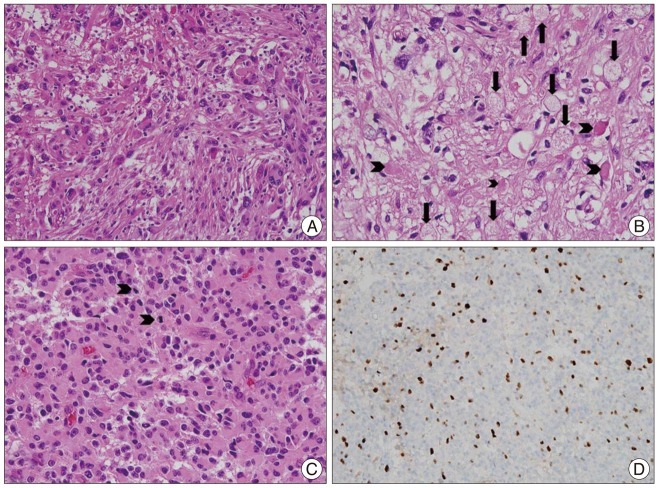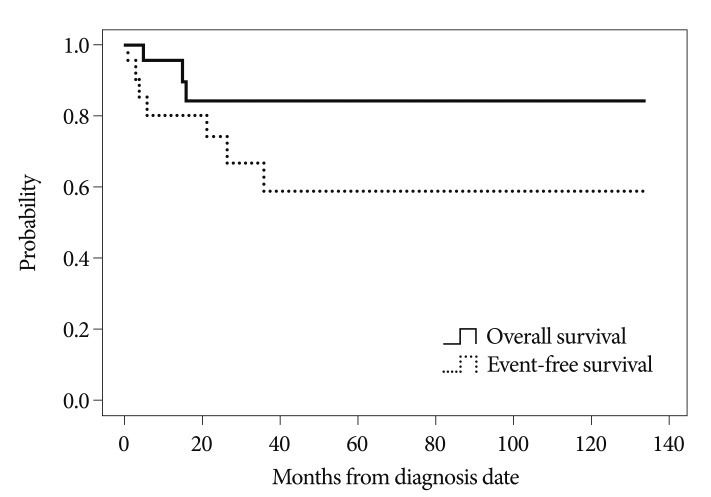J Korean Neurosurg Soc.
2013 May;53(5):281-287. 10.3340/jkns.2013.53.5.281.
Prognostic Factors and Therapeutic Outcomes in 22 Patients with Pleomorphic Xanthoastrocytoma
- Affiliations
-
- 1Department of Neurological Surgery, Asan Medical Center, University of Ulsan College of Medicine, Seoul, Korea. jhkim1@amc.seoul.kr
- 2Department of Pathology, Asan Medical Center, University of Ulsan College of Medicine, Seoul, Korea.
- 3Department of Neurosurgery, Ulsan University Hospital, University of Ulsan College of Medicine, Ulsan, Korea.
- KMID: 1426195
- DOI: http://doi.org/10.3340/jkns.2013.53.5.281
Abstract
OBJECTIVE
Pleomorphic xanthoastrocytoma (PXA) is a rare primary low-grade astrocytic tumor classified as WHO II. It is generally benign, but disease progression and malignant transformation have been reported. Prognostic factors for PXA and optimal therapies are not well known.
METHODS
The study period was January 2000 to March 2012. Data on MR findings, histology, surgical extents and adjuvant therapies were reviewed in twenty-two patients diagnosed with PXA.
RESULTS
The frequent symptoms of PXA included seizures, headaches and neurologic deficits. Tumors were most common in the temporal lobe followed by frontal, parietal and occipital lobes. One patient who died from immediate post-operative complications was excluded from the statistical analysis. Of the remaining 21 patients, 3 (14%) died and 7 (33%) showed disease progression. Atypical tumor location (p<0.001), peritumoral edema (p=0.022) and large tumor size (p=0.048) were correlated with disease progression, however, Ki-67 index and necrosis were not statistically significant. Disease progression occurred in three (21%) of 14 patients who underwent GTR, compared with 4 (57%) of 7 patients who did not undergo GTR, however, it was not statistically significant. Ten patients received adjuvant radiotherapy and the tumors were controlled in 5 of these patients.
CONCLUSION
The prognosis for PXA is good; in our patients overall survival was 84%, and event-free survival was 59% at 3 years. Atypical tumor location, peritumoral edema and large tumor size are significantly correlated with disease progression. GTR may provide prolonged disease control, and adjuvant radiotherapy may be beneficial, but further study is needed.
MeSH Terms
Figure
Reference
-
1. Berger MS, Deliganis AV, Dobbins J, Keles GE. The effect of extent of resection on recurrence in patients with low grade cerebral hemisphere gliomas. Cancer. 1994; 74:1784–1791. PMID: 8082081.
Article2. Crespo-Rodríguez AM, Smirniotopoulos JG, Rushing EJ. MR and CT imaging of 24 pleomorphic xanthoastrocytomas (PXA) and a review of the literature. Neuroradiology. 2007; 49:307–315. PMID: 17205313.
Article3. Davies KG, Maxwell RE, Seljeskog E, Sung JH. Pleomorphic xanthoastrocytoma--report of four cases, with MRI scan appearances and literature review. Br J Neurosurg. 1994; 8:681–689. PMID: 7718164.
Article4. Fouladi M, Jenkins J, Burger P, Langston J, Merchant T, Heideman R, et al. Pleomorphic xanthoastrocytoma : favorable outcome after complete surgical resection. Neuro Oncol. 2001; 3:184–192. PMID: 11465399.
Article5. Fu YJ, Miyahara H, Uzuka T, Natsumeda M, Okamoto K, Hirose T, et al. Intraventricular pleomorphic xanthoastrocytoma with anaplastic features. Neuropathology. 2010; 30:443–448. PMID: 20051018.
Article6. Giannini C, Scheithauer BW, Burger PC, Brat DJ, Wollan PC, Lach B, et al. Pleomorphic xanthoastrocytoma : what do we really know about it? Cancer. 1999; 85:2033–2045. PMID: 10223246.7. Grant JW, Gallagher PJ. Pleomorphic xanthoastrocytoma. Immunohistochemical methods for differentiation from fibrous histiocytomas with similar morphology. Am J Surg Pathol. 1986; 10:336–341. PMID: 3010749.8. Hamlat A, Le Strat A, Guegan Y, Ben-Hassel M, Saikali S. Cerebellar pleomorphic xanthoastrocytoma : case report and literature review. Surg Neurol. 2007; 68:89–94. discussion 94-95. PMID: 17537486.
Article9. Hammoud MA, Sawaya R, Shi W, Thall PF, Leeds NE. Prognostic significance of preoperative MRI scans in glioblastoma multiforme. J Neurooncol. 1996; 27:65–73. PMID: 8699228.
Article10. Hirose T, Ishizawa K, Sugiyama K, Kageji T, Ueki K, Kannuki S. Pleomorphic xanthoastrocytoma : a comparative pathological study between conventional and anaplastic types. Histopathology. 2008; 52:183–193. PMID: 18184267.
Article11. Iwaki T, Fukui M, Kondo A, Matsushima T, Takeshita I. Epithelial properties of pleomorphic xanthoastrocytomas determined in ultrastructural and immunohistochemical studies. Acta Neuropathol. 1987; 74:142–150. PMID: 3673505.
Article12. Kepes JJ. Pleomorphic xanthoastrocytoma : the birth of a diagnosis and a concept. Brain Pathol. 1993; 3:269–274. PMID: 8293186.13. Kepes JJ, Louis DN, Paulus W. Pleomorphic xanthoastrocytoma. Kleihues P, Cavenee WK. Pathology and Genetics of Tumours of the Nervous System. Lyon, France: International Agency for Research on Cancer;1997. p. 34–36.14. Kepes JJ, Rubinstein LJ, Eng LF. Pleomorphic xanthoastrocytoma : a distinctive meningocerebral glioma of young subjects with relatively favorable prognosis. A study of 12 cases. Cancer. 1979; 44:1839–1852. PMID: 498051.
Article15. Koga T, Morita A, Maruyama K, Tanaka M, Ino Y, Shibahara J, et al. Long-term control of disseminated pleomorphic xanthoastrocytoma with anaplastic features by means of stereotactic irradiation. Neuro Oncol. 2009; 11:446–451. PMID: 19164434.
Article16. Korshunov A, Golanov A. Pleomorphic xanthoastrocytomas : immunohistochemistry, grading and clinico-pathologic correlations. An analysis of 34 cases from a single Institute. J Neurooncol. 2001; 52:63–72. PMID: 11451204.17. Kros JM, Vecht CJ, Stefanko SZ. The pleomorphic xanthoastrocytoma and its differential diagnosis : a study of five cases. Hum Pathol. 1991; 22:1128–1135. PMID: 1743696.
Article18. Lach B, Duggal N, DaSilva VF, Benoit BG. Association of pleomorphic xanthoastrocytoma with cortical dysplasia and neuronal tumors. A report of three cases. Cancer. 1996; 78:2551–2563. PMID: 8952564.
Article19. Lipper MH, Eberhard DA, Phillips CD, Vezina LG, Cail WS. Pleomorphic xanthoastrocytoma, a distinctive astroglial tumor : neuroradiologic and pathologic features. AJNR Am J Neuroradiol. 1993; 14:1397–1404. PMID: 8279337.20. Louis DN, Ohgaki H, Wiestler OD, Cavenee WK, Organization WH. Pathology and Genetics of Tumours of the Nervous System : WHO Classification of Tumours. Geneve, Switzerlan: World Health Organization;2007.21. Macaulay RJ, Jay V, Hoffman HJ, Becker LE. Increased mitotic activity as a negative prognostic indicator in pleomorphic xanthoastrocytoma. Case report. J Neurosurg. 1993; 79:761–768. PMID: 8410257.
Article22. Marton E, Feletti A, Orvieto E, Longatti P. Malignant progression in pleomorphic xanthoastrocytoma : personal experience and review of the literature. J Neurol Sci. 2007; 252:144–153. PMID: 17189643.
Article23. Nakajima T, Kumabe T, Shamoto H, Watanabe M, Suzuki H, Tominaga T. Malignant transformation of pleomorphic xanthoastrocytoma. Acta Neurochir (Wien). 2006; 67–71. discussion 71. PMID: 15912255.
Article24. Pahapill PA, Ramsay DA, Del Maestro RF. Pleomorphic xanthoastrocytoma : case report and analysis of the literature concerning the efficacy of resection and the significance of necrosis. Neurosurgery. 1996; 38:822–828. discussion 828-829. PMID: 8692406.25. Perkins SM, Mitra N, Fei W, Shinohara ET. Patterns of care and outcomes of patients with pleomorphic xanthoastrocytoma : a SEER analysis. J Neurooncol. 2012; 110:99–104. PMID: 22843450.
Article26. Pignatti F, van den Bent M, Curran D, Debruyne C, Sylvester R, Therasse P, et al. Prognostic factors for survival in adult patients with cerebral low-grade glioma. J Clin Oncol. 2002; 20:2076–2084. PMID: 11956268.
Article27. Pope WB, Sayre J, Perlina A, Villablanca JP, Mischel PS, Cloughesy TF. MR imaging correlates of survival in patients with high-grade gliomas. AJNR Am J Neuroradiol. 2005; 26:2466–2474. PMID: 16286386.28. Rostomily RC, Hoyt JW, Berger MS, Kros JM, Alvord EC, Wilkins P, et al. Pleomorphic xanthoastrocytoma : DNA flow cytometry and outcome analysis of 12 patients. Cancer. 1997; 80:2141–2150. PMID: 9392337.29. Schoenegger K, Oberndorfer S, Wuschitz B, Struhal W, Hainfellner J, Prayer D, et al. Peritumoral edema on MRI at initial diagnosis : an independent prognostic factor for glioblastoma? Eur J Neurol. 2009; 16:874–878. PMID: 19473360.
Article30. Smith JS, Chang EF, Lamborn KR, Chang SM, Prados MD, Cha S, et al. Role of extent of resection in the long-term outcome of low-grade hemispheric gliomas. J Clin Oncol. 2008; 26:1338–1345. PMID: 18323558.
Article31. Stummer W. Mechanisms of tumor-related brain edema. Neurosurg Focus. 2007; 22:E8. PMID: 17613239.
Article32. Thomas C, Golden B. Pleomorphic xanthoastrocytoma : report of two cases and brief review of the literature. Clin Neuropathol. 1993; 12:97–101. PMID: 8477554.33. Tien RD, Cardenas CA, Rajagopalan S. Pleomorphic xanthoastrocytoma of the brain : MR findings in six patients. AJR Am J Roentgenol. 1992; 159:1287–1290. PMID: 1442403.34. Weldon-Linne CM, Victor TA, Groothuis DR, Vick NA. Pleomorphic xanthoastrocytoma. Ultrastructural and immunohistochemical study of a case with a rapidly fatal outcome following surgery. Cancer. 1983; 52:2055–2063. PMID: 6194876.
Article35. Yang WQ, Huang B, Liang CH. Pleomorphic xanthoastrocytoma in the lateral ventricle with extensive subarachnoid dissemination : report of a case and review of the literature. Chin Med J (Engl). 2012; 125:396–399. PMID: 22340580.
- Full Text Links
- Actions
-
Cited
- CITED
-
- Close
- Share
- Similar articles
-
- Cerebellar Pleomorphic Xanthoastrocytoma in an Infant: Case Report
- A Case of Pleomorphic Xanthoastrocytoma
- Coexistence of Arteriovenous Malformation and Pleomorphic Xanthoastrocytoma: Case Report
- Pleomorphic Xanthoastrocytoma: Report of 3 Cases
- Pleomorphic Xanthoastrocytoma in a 58-year-old Woman: A case report




